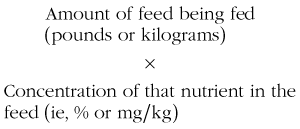Nutrition
Total Diet Assessment
Basic Information 
Overview and Goal(s)
• It is important to realize that forages (hay and pasture) provide a significant portion of the horse’s daily nutrient requirements. Proper nutritional principles require that we recognize the contribution of forages and adjust the concentrate (grain) portion of the diet accordingly to meet the horse’s requirements. Recommending a feed and/or supplement without assessing the total diet may adversely affect the horse’s health and performance.
• Thus selection of the concentrate and/or supplement should be based on the forage being fed and supply the portion of the horse’s requirements not met by that forage. Furthermore, adding supplements to the horse’s diet is more a rule than an exception in today’s horse industry. So understanding how to assess the total diet is the responsible path to follow.
Key Points
• All feedstuffs offered to horses have some level of most nutrients.
• Horses typically consume more forage than concentrate (grains). Consider the contribution of forage to meeting the horse’s requirements.
• Certain nutrient requirements may be met by the forage alone.
• One must understand what the forage is providing before designing or selecting the appropriate concentrate.
• The nutrient requirements of the horse are determined by the National Research Council (NRC) Committee on Horse Nutrition (2007).
Procedure
• Total intake is determined by calculating the amount of each nutrient that is supplied by all feeds offered to the horse—hay, pasture, grain, and supplements.
• Commercial software programs are available to perform these calculations and compare the results to NRC 2007 requirements without the tedious calculations outlined later.
• NOTE: Calculations for nutrients whose requirements are not addressed by NRC 2007 will be the same as described here, but the relevance is more subjective. Nutrients such as starch, sugar (nonstructural carbohydrates [NSC] = sugar + starch), acid detergent fiber (ADF), neutral detergent fiber (NDF), lignin, and ash may have value, but no established requirements exist.
• Values for certain vitamins, minerals, and amino acids are often listed on feed tags, but assessing the relevance is purely speculation when no requirement has been established.
• Nutrient concentration values for forages can be obtained most accurately by laboratory analysis, but NRC and other database values can be used in lieu of laboratory analyses.
• Most laboratories have information on proper sampling techniques for hay, pasture, and concentrates. Valid results are only obtained when proper sampling techniques are followed.
• Nutrient concentration values for grains, concentrates, and supplements will be found on the product labeling but can also be submitted for laboratory analysis. Take care to note possible differences in label concentrations with respect to feeding recommendations, especially with supplements. Supplement concentrations are often listed as “per pound,” but feeding recommendations are in ounces or grams.
In general, how is the amount of nutrient supplied by a feed calculated?
Stay updated, free articles. Join our Telegram channel

Full access? Get Clinical Tree



